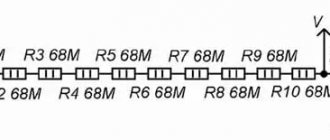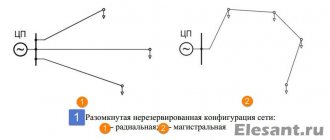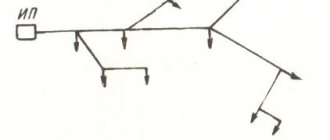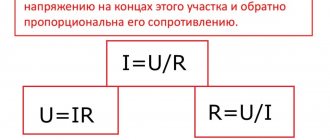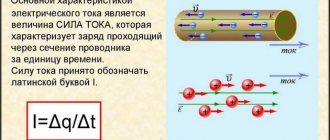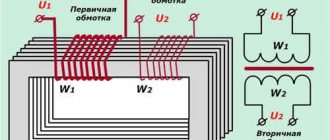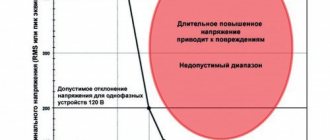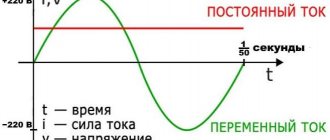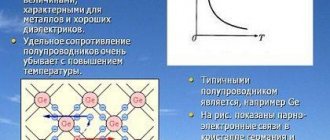What it is?
The term “induced voltage” hides the potential that arises in the zone of electromagnetic influence of existing electrical installations or electrical conductors.
Such interference can occur in the area of high-voltage lines, high-U electrical installations and even a household network. The phenomenon of induced voltage consists of 2 components, which we will consider in more detail.
Electrostatics
The creation of potential is explained by the propagation of an electric field from a source of electricity located in close proximity.
The greatest impact is typical for two wires that are located next to each other and are parallel to each other. In this case, one is under U, and the second is not.
The magnitude of the induced voltage depends on the following aspects:
- The size of the potential difference.
- The distance from a voltage power source to another element.
For better understanding, the system can be compared to one or more capacitors. Formally, the pickup is formed along the entire length of the conductor.
To avoid charge accumulation, it is necessary to ground the disconnected conductor. In this case, the induced voltage will go into the ground, and the work will be safe for humans.
To calculate static voltage, you need to multiply two elements:
- Capacitive influence coefficient. Its size can be obtained from the reference book, and the parameter itself depends on the distance to the source U and the type of conductor.
- Operating voltage.
The larger U is and the closer the conductor is, the higher the induced parameter.
To calculate the maximum induced voltage, the formula is used:
Electromagnetic component
There is another type of interference - EM induced voltage. Its essence is the spread of a magnetic field over a certain area in all directions from the conductor.
The stronger the EM field, the higher the induced U in the disconnected conductor.
The induced EMF in a disconnected power transmission line will be equal to:
When a conductor is grounded at the point of connection with the ground, the potential will be zero, but as it moves away from this place it will increase. This means that the maximum potential difference parameter will be at the most distant ends of the line (VL or CL).
The voltage at point x relative to the ground will be equal to:
Induced voltage
This phenomenon threatens people's lives and health. High induced voltage damages high-quality equipment, creates interference, and worsens the economic performance of power lines. Problems are eliminated using special techniques.
Nature of the phenomenon
To understand the causes of the problems, you need to remember the basic concepts and terms from the school physics course. It is known that the passage of alternating current through a circuit provokes the formation of an electromagnetic field. Its force potential decreases in proportion to the square of the distance.
If a conductor is placed nearby, a current is induced in it. Without further explanation, the potential danger of electricity in a cable or other piece of equipment that is not connected to a power source is clear.
Causes
A detailed study of the noted processes allows not only to define the induced voltage. You need to figure out how to get rid of potential dangers. Careful testing using specific examples will help create a strong defense.
On an overhead line (VL)
In such objects the processes under consideration manifest themselves with particular force. The high-voltage characteristics of the circuits have a significant negative impact. It should also be noted the relative proximity of the wires. Increasing the distance significantly complicates the design, which is accompanied by additional investment costs. The potential induced in a de-energized section of the line can rise to an extremely dangerous level.
Large electrical interference can create significant problems. Its value depends on the following parameters:
- voltage in the working part of the networks;
- current strength (connected load);
- relative position of conductors;
- level of humidity, pollution, and other factors that change the conductivity of the intermediate medium.
The total potential can be divided into two parts. Static – creates an electric field from the nearest wire. The induced voltage is formed throughout the entire section of the adjacent conductor; it is not necessarily part of the line. Similar phenomena can be recorded by measuring instruments in support masts, fasteners and other elements with conductive properties. An effective safety measure in this case is to ground certain parts of the structure.
The other component is formed by an alternating electromagnetic field near the phase wires. The main trouble is the lack of simple solutions in the field of electrical safety. In this situation, even effective grounding will not help. High-quality insulation that is not capable of blocking the penetration of electromagnetic waves is useless. The potential at a certain point depends on the field strength parameters and the distance to the signal source.
In electrical installations
Similar negative phenomena are observed in local networks. Maximum voltage levels are in disconnected line switches. Induced currents can form in a transformer, housing, or mechanical drive of an electrical installation. As in the examples discussed above, the greatest difficulties arise when searching for effective methods of dealing with the variable component.
For your information. Sources of danger can be a metal ceiling, floor, or other functional or decorative element of a building structure.
In the apartment
Reducing the voltage to 220 V reduces but does not completely eliminate possible troubles. The increased energy consumption of a modern apartment should be taken into account. Cooktops, ovens and air conditioners operate using high currents. The total power of the new equipment is tens of kW. Additional problems are created by the frequency of switching on and the reactive nature of the loads.
For your information. A good example is LEDs operating in a disconnected circuit, located next to the wires of the 220V power supply.
In electrical wiring
The next typical case is a break (disconnection) of the neutral wire. If you use a multimeter according to standard measurement methods, it is easy to detect the presence of two phases in the outlet. It is clear that this is impossible in a standard 220 V household network. The second voltage will induce electromagnetic radiation in the disconnected conductor. To restore the normal state of the system, it is enough to restore the damaged current circuit.
What is the danger of the phenomenon
Variable and static potentials occur in disconnected parts of networks, which are a surprise to users. These interferences interfere with the normal operation of the RCD and AV. When a circuit is closed through the human body, the automation reacts promptly in normal mode. However, induced voltage is generated in areas that are not protected in any way.
What is the danger?
Induced voltage is no less dangerous than normal potential. If during a conductor short circuit the relay protection operates and cuts off the emergency section, in the case of an induced U, everything is more complicated. Here, protective devices will not work, so a person may find himself under prolonged exposure to negative factors.
During a short circuit on a working line, which is located near the disconnected section, on a de-energized overhead line, the induced voltage increases several times. As a result, repair personnel are exposed to the induced U, which can lead to burns and even cardiac arrest. The parameter value can reach 10-20 thousand Volts.
The PUE states that U above 25 V is already dangerous to human health. That is why it is important to carefully approach this circumstance and take measures to provide additional protection. How to protect yourself from wiring will be discussed later in the article.
How does it arise
Let's consider a completely ordinary situation. There is a certain power line that currently has no potential. This may be a line that has not been put into operation, or an existing facility where repair work is being carried out. On any section of this conductor there may be another line or electrical installation through which electric current flows. If the conductors are located in parallel, a transformer effect occurs: the influencing line (which is energized) has an inductive effect on the disconnected one. Due to this, electric current begins to flow through the passive conductor, and a potential difference arises, which can have a value similar to the voltage in the source.
If you de-energize any of the power lines in the illustration, then under the influence of neighboring conductors (which are under voltage), an induced voltage will appear on the disconnected wires.
If you start work on a passive line without taking special safety measures, you can get an electric shock, even death.
Reasons for appearance
When considering a tip-off, it is important to understand the reasons for its occurrence. For a better understanding, let's consider several situations - for an apartment, electrical wiring, electrical installations and overhead lines.
In the apartment
Interference in a regular 220 V network appears when the 0th conductor on the overhead line breaks or before entering the apartment (house). If you check the voltage using an indicator, the light will glow in any of the holes.
In fact, U is present only on one of the wires (phase), and the second one receives the induced potential. A phenomenon appears such as two phases in an outlet.
After the line is restored or zero is returned, the situation returns to normal.
When performing repair work in an apartment, it is necessary to turn off the input circuit breaker or remove the fuses to prevent voltage.
In electrical wiring
One of the signs of induced voltage is the glow of the housekeeper when the lights are off. In this case, the voltage can reach 40-60 V.
This situation arises when parallel laying of lines powering sockets and lighting devices in the apartment.
To fix the problem, you need to review the wiring routes and make sure that grounding or grounding is performed correctly.
But there is another reason. When creating wiring, 2 or 3 core wires are used. As a rule, cable products are placed in boxes, from where the conductors are directed to their consumers.
If the switch separates the neutral wire rather than the phase wire, an induced U appears. It has a small value, as noted above, but it is enough to ignite the diode lighting.
To solve the problem, you need to swap the phase and zero. This is not always possible, because one of the wires from the box goes directly to the light source and does not pass through the switch.
In electrical installations
Switches, power transformers, current and voltage transformers, as well as other electrical installations are inevitably connected to the power line. That is why they often come under induced voltage and most often this happens when the 0th conductor breaks.
Many electrical installations use insulated cables that contain tightly packed conductors.
Despite the short length of the sections, strong interference can occur with great risks for personnel. That is why, when performing such work, it is important to take protective measures, use PPE and follow the requirements of the PUE.
On the power line
We noted above that the electrostatic component of the pickup has an identical potential along the entire length of the conductor. To calculate the required value, the capacitive coupling coefficient is multiplied by the operating influencing voltage.
To ensure the protection of workers, one grounding at any point is sufficient.
Note that static U can arise not only in the presence of nearby EM fields, but also other factors - lightning or aurora.
The mechanism of occurrence of induced voltage and measures to protect against it
Electrical repair work both on high-voltage transmission lines and inside the apartment has an increased danger due to a number of factors. The most dangerous and common is the threat of electric shock. Its cause may be induced voltage, a phenomenon dangerous to human health due to its hidden nature. To protect against it, you need to understand the essence of this phenomenon.
Nature of the phenomenon
The occurrence of collateral or induced voltage in a conductor occurs according to the same principle as the voltage in the secondary winding of a transformer. The essence of the phenomenon is as follows:
- when electric current moves around a conductor, a magnetic field arises;
- a change in current strength and its direction causes a change in the magnetic field;
- a changing magnetic field separates unlike charges, which leads to the appearance of a potential difference, that is, to voltage.
Without going into physical details, pickup voltage is the occurrence of a potential difference in a metal conductor that is not connected to a source of electric current, under the influence of an electric current in another conductor located next to it. The closer the conductors are to each other and the higher the potential difference in the conductor connected to the network, the greater the voltage on the insulated conductor.
The effect of induced electric current has two components: electromagnetic and electrostatic. The first does not pose a threat to human life, but may affect the performance of some instruments and devices. The second is more dangerous for humans; at voltages above 25 V, additional safety measures are taken.
Hazards and protective measures
It is believed that the potential difference from interference is more dangerous than normal. Standard protective devices are not designed to counteract it. When working on high-voltage power lines, a potential difference of several kilovolts may occur on a disconnected line. Carrying out work from towers or operating cranes near power lines is carried out with permission and with the use of additional protective measures, since a potential difference may occur on the metal part of the equipment and machinery. This could result in electric shock to people and damage to equipment.
The necessary safety measures are specified in the safety regulations when performing the relevant work. The simplest and most effective is a disconnected line grounding device. For reliability, the grounding loop has two lines that duplicate each other. If one is accidentally broken, grounding will be carried out through the other. Long lines are divided into separate sections, which are grounded separately.
You should remember about safety precautions and personal protective equipment when carrying out measuring work. The measurement circuit is assembled in advance and then connected to conductors under actual voltage or supposed induced voltage.
TB requirements:
- dielectric gloves are put on your hands;
- on your feet - rubber boots that have been tested and have the appropriate tag;
- Clothes must be dry and all work must not be carried out in the rain.
All connecting wires must have proper insulation designed for a potential difference of at least 1 kV. If it is necessary to change the scale limits of the measuring device, disconnect the entire measuring circuit from the overhead line.
Crosstalk in a household network
In an apartment, private house or office space, you can also encounter the phenomenon of voltage pickup. Typically, wires with a 220 V power supply have two wires: phase and neutral. When the neutral wire breaks, a small potential difference appears in it. If you look for a phase in a socket with a broken “zero” using a voltage indicator, the measuring device will show it on two contacts at once, but in fact the phase is only on one contact, the pickup voltage is on the other.
This situation can be misleading when performing electrical repair work in an apartment. When the break in the neutral wire is eliminated, everything returns to normal - the phase is one and where it is supposed to be.
Another manifestation of induced voltage is the slight glow of LED lamps when turned off . LEDs are sensitive to small voltages. When cross-talk occurs, a potential difference of only a few volts occurs, but this is enough to emit a low-intensity light flux from LEDs, visible only in the dark.
How to protect yourself, security measures
From the above it is clear that induced voltage carries great risks, which requires responsibility for implementing measures to protect people from falling into the danger zone.
Organizational security measures:
- Workers performing work in the wiring area must have the 3rd electrical safety group, and the work manager must have the 4th.
- Experience in repair and maintenance of power lines, as well as lightning protection elements.
- Organization of safety parameters near the workplace, implementation of activities specified in the application and work permit.
- The neutral wire in the group being measured is considered to be located under U.
- The beginning and completion of work is documented in writing. As a rule, an admission log is filled out with the signature of the employees, and an admission order is filled out.
Measurements and work cannot be carried out in conditions of heavy fog or wind, precipitation or poor visibility. If during the measurement process a worker identifies a damaged element of an overhead line or cable line, work is stopped until the problem is resolved.
When working on guided lines, the following nuances must be taken into account:
- Grounding must be within sight of the workplace.
- If there is only static voltage, one grounding is sufficient, but for reliability it is better to install a grounding electrode in two places. If one of the devices fails, the second one will back up.
- In the case of electromagnetic wiring, more serious safety measures are taken. In this case, grounding is installed directly at the workplace. In this case, the induced potential at the place where the work is performed will be zero.
Grounding is a reliable way to protect against induced voltage. But even in this case, the disconnected line will be negatively affected.
To work, you can choose one of the options:
- Disabling electrical installations that are parallel to the operating line. In this case, repair work must be carried out as quickly as possible to avoid downtime of consumers without electricity or a long-term decrease in network reliability.
- Dividing the line being repaired into several sections that do not have electrical connections. The principle mentioned above applies here. The point is that the amount of pickup directly depends on the length of the section.
- Work under voltage or with its disconnection, but with the use of special personal protective equipment. In this case, the employee’s actions are somewhat constrained, but it is possible to avoid disconnecting or reducing the reliability of the network.
To ensure personal safety, the following products are used:
- Voltage alarms - indicate the presence of U or interference.
- The use of protective clothing and dielectric-based mats to prevent the passage of current through the human body.
- Using voltage indicators, as well as electrically insulating rods to check the level of induced U.
- Work in boots and insulating gloves.
When using measuring devices and personal protective equipment, it is necessary to focus on class U for which they are intended.
Residual phenomenon in action
When the generator of the described device generates a voltage that subsequently enters the measured network, a potential difference is formed between the ground loop and the wire. Subsequently, a container is created in which a certain charge is present.
- Voltage stabilizer without feedback
When the measuring wire is disconnected, the circuit in the megohmmeter is broken. But the potential is subject to partial conservation due to the appearance of a capacitive charge in the bus or wire. Contact of a person with such an area will result in electrical injury due to a current charge that will pass through the body. Portable grounding with mandatory insulation of its handle to safely eliminate capacitive voltage will help to avoid such a danger.
Before turning on the megohmmeter for operation, you should make sure that there is no residual charge in the voltage circuit being tested. In this case, it is recommended to use a voltmeter and special indicators that provide the necessary signal. The described device makes it possible to perform a number of procedures, in particular:
- checking the insulation of a ten-core cable in relation to ground;
- Carrying out the necessary measurements in each core relative to each other;
- determining the quality of insulation between residential passages.
In any case, portable grounding must be used. To ensure proper and safe operation, the pre-grounding conductor is closed to the circuit on the ground. It remains in this state until all activities are completed. The other end of the conductor is connected to an insulating rod, with the help of which grounding is ensured for the subsequent elimination of residual charge.
Results
The danger of induced voltage cannot be underestimated. In the absence of the necessary protection and the disconnected line is located in the zone of influence of a live conductor, interference can be life-threatening.
Awareness of possible risks, installation of grounding, following the rules of the Electrical Regulations and the use of PPE allows you to reduce the danger to a minimum.
These rules are mandatory for electrical installations, on cable lines and overhead lines, and must also be taken into account when performing work on a 220 V household network.
Subscribe to the newsletter
Induced voltage is a physical phenomenon and occurs at high voltage levels.
It can arise both from the impact of constructed and operated electrical installations (overhead power lines and electrical substations), and as a result of natural thunderstorm phenomena, in which high-voltage electrical discharges are observed.
On overhead power lines (OHL), this impact is taken into account at an operating voltage of 220 kV and above. Let us consider the features of the appearance of induced voltage using the example of two overhead lines running parallel along the entire route.
Measurement of the induced line voltage is carried out by organizations operating overhead lines and in accordance with developed measurement techniques. Based on the measurement results, a List of overhead lines is developed that are under induced voltage after switching off. Further, in order to ensure the safety of personnel for work under induced voltage, technological maps (TC) and work execution projects (WPP) are developed as part of organizational measures. TC (PPR) determine the technology for performing work under induced voltage, excluding the possibility of electric shock to personnel from overhead line elements under induced voltage.
Requirements for the organization of work are regulated by the Rules for labor protection during the operation of electrical installations, approved by order of the Ministry of Labor of the Russian Federation dated June 24, 2013 No. 328n.
Examples of existing overhead lines that have mutual influence:
Source
Inducing voltage on home electrical lines
Of course, we are not talking about values of hundreds or thousands of volts. However, 40–60 volts can be obtained, and this is already life-threatening. Probably, many have observed the faded glow of energy-saving lamps when the lights are turned off. This is a sign of the presence of induced voltage. As a rule, such situations arise when parallel laying of the power lines of the electrical outlet network and lighting.
There is nothing to be afraid of when carrying out work: you still disconnect the entire home network from the input voltage. And to localize problems like glowing housekeepers, you should review the wire laying routes and check the working grounding and grounding.
Video on the topic
Excellent and clear article. I quickly figured out the issue.
Thank you. Respect to the author.
The relevance of the article “Analysis of the main changes in POTEE for work under induced voltage” (authors: I.V. Korolev, O.S. Shcherbacheva, A.M. Borovkova, D.A. Burdyukov) is undeniable. In particular, the “method” of working without grounding overhead lines at the ends in the switchgear with grounding only at the workplace has been actively discussed in periodicals for more than 35 years. In 1984, the rules introduced a requirement to divide overhead lines into those that were and were not under induced voltage according to its value of 42 V (later 25 V), a method of working without grounding overhead lines at the ends in the switchgear with grounding only at the workplace appeared, and a requirement appeared to compile lists of overhead lines under induced voltage. These innovations were presented as a solution to labor safety problems when working on overhead lines under induced voltage. But at the same time, all previously existing requirements in the rules for protection from induced voltage when working on overhead lines and outdoor switchgear equipment were retained and are still included in the rules in their original form. The above-mentioned innovations were edited five times from 1984 to 2013. At the insistence of operating organizations, the ORGRES company only in 1993 released a method for measuring the amount of “induced voltage” on overhead lines. And it became obvious to specialists in the operation of overhead lines and substations that the theory on which the “innovations” were based was erroneous: the measurement of the induced voltage was not carried out between an ungrounded wire (lightning cable) at the measurement site and grounded conductive parts, but the voltage drop was measured on a section of land 15 - 20 in length m from the place of grounding of wires (lightning cables). Such a substitution of the definition of the term and the attached graphs of the distribution of the voltage drop on the ground electrode along the overhead line unacceptably distorted the provisions of electrical engineering. There were inconsistencies with the terms and requirements of PUE-5(6), and now PUE-7 section 1.7. "Grounding and protective measures for electrical safety." In 2009, the methodology of the ORGRES company migrated to the methodology of JSC FGC UES. The magnitude of the voltage drop across the support ground electrode, of course, depends on many factors. But there is simply no connection between the magnitude of the voltage drop on the ground electrode and the magnitude of the induced voltage on this support between the ungrounded wire (lightning cable) and grounded conductive parts, between the wires of the split phase, as well as the magnitude of the voltage between the wires (lightning cables) when cutting (connecting). The magnitude of the induced voltage reaches 1 - 50 kV on overhead lines of different voltage classes (this is known to electric linemen), and not 25-50 V (calculated according to the methods of the ORGRES company or JSC FGC UES). The magnitude of the voltage drop across the ground electrode, even 25 - 50 V, is reduced to zero and does not affect the safety of work when performing POTEEU clause 38.53. “Steel traction ropes used when installing wires on overhead lines under induced voltage must first be secured to the traction mechanism and grounded to the same ground electrode as the wire to equalize the potentials. Only after this is it allowed to attach the rope to the wire. The wire and the traction rope can be disconnected only after their potentials have been equalized, that is, after each of them has been connected to a common ground electrode. (clause as amended by Order of the Ministry of Labor of Russia dated February 19, 2016 N 74n).” For lightning cables, it does not matter whether the overhead line is grounded or ungrounded in the switchgear. Consequently, it would never occur to an electrician to measure and divide overhead lines into those that are and are not under induced voltage on the basis of this measurement when drawing up a PPR. Changes in POTEEU specified in Order of the Ministry of Labor of Russia dated 02/19/2016 No. 74n “On introducing changes to POTEEU, approved by Order of the Ministry of Labor of Russia dated 07/24/2013 No. 328n” bring clarity to the definition of places on overhead lines where there is induced voltage. The indication that the induced voltage is present on ungrounded wires (ground wires) of the overhead line grounded at the ends at the proposed work site is fundamental. It is fundamental to indicate the use of a method for equalizing the potentials of disconnected current-carrying and conductive parts in the workplace, which complies with the requirements of the PUE. All the requirements for grounding on overhead lines at the ends in the switchgear and at workplaces, as indicated at the beginning, preserved from the edition of the Rules until 1984, become clear. These surviving requirements fully ensure labor protection when working under induced voltage. A situation arose when these same requirements allowed the personnel not to pay attention to the presence of text related to the division of overhead lines into those under induced voltage and those not under induced voltage, and the authors of the “method” did not have an idea of how labor protection was ensured. Inexperienced personnel attempting to apply the “method” inevitably increased injury rates. That is, the overhead line, in accordance with the requirements of POTEEU, which actually provides protection from induced voltage, must be grounded at the ends in the switchgear, when cutting (connecting) wires (lighting cables), connecting to the wires (lighting cables) of aerial platform cradles, rigging and tools. It is important to note that the procedure for installing and maintaining the reliability of grounding must be observed when preparing the workplace, during work, and upon completion of work both on overhead lines and on substation equipment. All these grounds (grounding conductors) perform the function of equalizing the potentials of current-carrying and non-conducting parts (including the ground in the work area), which is a sufficient requirement according to PUE-7 section 1.7. "Grounding and protective measures for electrical safety." Consequently, the so-called “method of working without grounding overhead lines at the ends in the switchgear with grounding only at the workplace” cannot be used without taking measures to equalize the potentials of wires (lighting cables), rigging, tools and ground. If it is possible to exclude the approaches of the “method of working without grounding the overhead lines at the ends in the switchgear with grounding only at the workplace,” then the POTEEU will acquire an electrically understandable justification for safety measures, and there will also be compliance with the safety measures specified in different sections of the POTEEU for work on the overhead lines and RU equipment . This will eliminate the rules from mentioning the value “25 V”, the need to measure the magnitude of induced voltage on overhead lines, divide and compile lists of overhead lines into those under induced voltage and those not under induced voltage, eliminate the production of “protective equipment against induced voltage”, correctly apply the method of working under voltage, and will also bring the rules in line with the PUE, which states that it is always necessary to protect personnel and the population. In the article under discussion, it was no coincidence that attention was drawn to the fact that the value of 25 V does not correspond to the minimum permissible value; that the recalculation of the measured value of the voltage drop across the ground electrode is not determined; that according to Order No. 328 it was allowed to determine overhead lines for inclusion in the list by calculation, and according to Order No. 74 only by measurements; that the design of the influencing network is constantly changing; that there are no full-fledged TC and PPR; that there are no methodological manuals and programs for theoretical and practical training of personnel; that they cannot release a method for measuring induced voltage (it is known that operating organizations refused to measure according to the methods and design of a new one, proposing to measure voltage drop on grounding conductors that appears unknown from what currents. Conclusions 1. Order of the Ministry of Labor of Russia dated February 19, 2016 No. 74n “On introducing amendments to POTEEU, approved by order of the Ministry of Labor of Russia dated July 24, 2013 No. 328n "is a fundamental breakthrough in labor protection when working on overhead lines and on substation equipment under induced voltage. 2. Organizations responsible for the quality of safety measures requirements need to bring the Rules into compliance with the basics of electrical engineering and the requirements of the PUE, recognize the unity of the laws of physics for overhead lines and substation, and also exclude the text related to the “method of grounding overhead lines at one point.” 3. Methods for measuring “induced voltages on overhead lines” from ORGRES (1993) and JSC FGC UES (2009) is officially cancelled.
